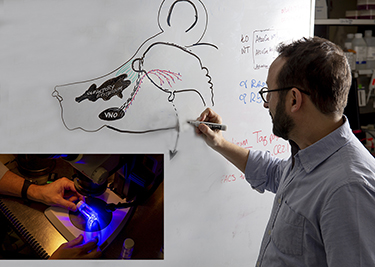An Innovative Path to the Brain
Charting the olfactory pathways to neurological discovery, Paolo Forni of the University at Albany has received more than $3.439 million in National Institutes of Health (NIH) awards over a six-month period — a noteworthy achievement, especially for a young investigator.
Forni, an assistant professor of Biological Sciences, this month received his third significant NIH award since September of last year. Two are prestigious R01 grants — an R01 is the original NIH award, targeted at health-related research — and the other an R15 grant that has been involving students in Forni’s research while enhancing the overall research environment at UAlbany.
“The fact that Paolo has garnered three NIH awards at this early stage of his career is remarkable,” said Professor Richard Cunningham, chair of Biological Sciences. “These awards come from two different Institutes at NIH and show his broad interests in developmental neurobiology. I cannot remember another junior faculty member in the Biological Sciences who has had this level of success in grant funding in my 35 years at UAlbany.”
A native of Italy who received his PhD from the University of Turin, Forni focuses his research on understanding the basic molecular mechanisms related to neuronal identity. His work aims at the identification of genetic causes of congenital and degenerative neurological disorders.
“The nervous system is like a universe of cells that forms complex connections and networks that make us what we are, what we feel and what we can do,” he said. “But our understanding of what defines the identity of each neuronal cell and what it will connect with is still modest.”
Following Unique Migration Pathways
The area of a vertebrate’s body in which Forni charts neural paths to the brain makes his work singular — he looks at mammalian neurons that form in the olfactory passages of rodents. Notably, during embryonic development, some of the neurons that form in the nose migrate to the brain, where they control the sexual hormonal axis. Forni’s group investigates this unique migration.
 |
|
Forni draws a cartoon representing the head of a mouse with the the terminal nerve (red) projecting from the nasal area to the basal forebrain. In the insert, he analyzes a sample of a mouse's brain using a dissection stereomicroscope.
|
“We use the olfactory system of rodents to discover new molecular mechanisms underlying the normal and pathological development of the nervous system," he said.
Forni’s three latest NIH grants are:
- Role of Inductive Signals Released by Nasal Mesenchyme and Brain in Controlling Terminal Nerve Development and GnRH-1 Neuronal Migration — one year, $450,000, an R015 awarded in September of 2018
- Molecular Mechanisms Controlling Differentiation and Circuit Formation of Vomeronasal Sensory Neurons — five years, $1.812 million, an RO1 awarded in December of 2018
- Understanding the Role of the Transcription Factor Gli3 in Kallmann syndrome and normosmic form of idiopathic hypogonadotropic hypogonadism — five years, $1.117 million, an R01 awarded this month
Forni, who arrived at UAlbany in 2014, noted that the R15 project was the foundation of the transcription factor Gli3 R01 study, with both studies funded by NIH’s Eunice Kennedy Shriver National Institute of Child Health and Human Development (NICDH). In these, he and Fornilab team are studying the normal and pathological development of the gonadotropin-releasing hormone (GnRH) system.
The two studies are directed to understanding how specific genetic mutations can impair neuronal development and lead to a lack of fertility in humans. During embryonic development, GnRH neurons first form in the nose and then migrate into the brain.
“Defective migration of the GnRH neurons negatively affect the production of sex hormones and therefore the onset of puberty and fertility in humans,” Forni said. “Puberty is the process of physical changes that allows our body to reach sexual maturity in our younger years. The hormonal changes that trigger puberty are controlled by the brain, where a specialized population called GnRH neurons modulate the release of signaling molecules that instruct ovaries or testes to produce sex hormones.”
His study dealing with Vomeronasal Sensory Neurons, funded by the National Institute on Deafness and Other Communication Disorders (NIDCD), aims to discover molecular principles that define how the specialized olfactory neurons acquire their specific identity and form precise connections to the brain.
“This is relevant for human health, as olfactory dysfunctions are an early marker of cognitive decline associated with aging, metabolic disorders, and several neurological disturbances — including depression, Parkinson’s disease, multiple sclerosis, schizophrenia and dementia,” said Forni.
His research involves his Fornilab, which includes four graduate and several undergraduate students (he has trained 19 to date), plus local and international collaborations. The local collaborations include UAlbany’s Morgan Sammons of Biology and Gabriele Fuchs of Biology and The RNA Institute on the studies funded by NICDH, and Sammons and Damian Zuloaga on the NIDCD study.
![]() For more news, subscribe to UAlbany's RSS headline feeds
For more news, subscribe to UAlbany's RSS headline feeds




